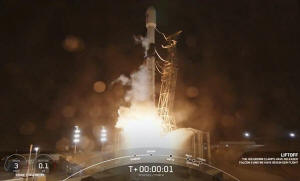NASA's newest space telescope blasts off to map the entire sky and
millions of galaxies
[March 12, 2025]
By MARCIA DUNN
NASA’s newest space telescope rocketed into orbit Tuesday to map the
entire sky like never before — a sweeping look at hundreds of millions
of galaxies and their shared cosmic glow since the beginning of time.
SpaceX launched the Spherex observatory from California, putting it on
course to fly over Earth’s poles. Tagging along were four suitcase-size
satellites to study the sun. Spherex popped off the rocket's upper stage
first, drifting into the blackness of space with a blue Earth in the
background.
The $488 million Spherex mission aims to explain how galaxies formed and
evolved over billions of years, and how the universe expanded so fast in
its first moments.
Closer to home in our own Milky Way galaxy, Spherex will hunt for water
and other ingredients of life in the icy clouds between stars where new
solar systems emerge.
The cone-shaped Spherex — at 1,110 pounds (500 kilograms) or the heft of
a grand piano — will take six months to map the entire sky with its
infrared eyes and wide field of view. Four full-sky surveys are planned
over two years, as the telescope circles the globe from pole to pole 400
miles (650 kilometers) up.
Spherex won’t see galaxies in exquisite detail like NASA’s larger and
more elaborate Hubble and Webb space telescopes, with their narrow
fields of view.
Instead of counting galaxies or focusing on them, Spherex will observe
the total glow produced by the whole lot, including the earliest ones
formed in the wake of the universe-creating Big Bang.
“This cosmological glow captures all light emitted over cosmic history,”
said the mission’s chief scientist Jamie Bock of the California
Institute of Technology. “It’s a very different way of looking at the
universe,” enabling scientists to see what sources of light may have
been missed in the past.

[to top of second column]
|

In this image from video provided by SpaceX, the company's SpaceX’s
Falcon rocket, carrying NASA's newest space telescope, Spherex,
lifts off from Vandenberg Space Force Base, Calif., Tuesday, March
11, 2025. (SpaceX via AP)

By observing the collective glow, scientists hope to tease out the
light from the earliest galaxies and learn how they came to be, Bock
said.
“We won’t see the Big Bang. But we’ll see the aftermath from it and
learn about the beginning of the universe that way,” he said.
The telescope’s infrared detectors will be able to distinguish 102
colors invisible to the human eye, yielding the most colorful,
inclusive map ever made of the cosmos.
It's like "looking at the universe through a set of rainbow-colored
glasses,” said deputy project manager Beth Fabinsky of NASA’s Jet
Propulsion Laboratory.
To keep the infrared detectors super cold — minus 350 degrees
Fahrenheit (minus 210 degrees Celsius) — Spherex has a unique look.
It sports three aluminum-honeycomb cones, one inside the other, to
protect from the sun and Earth's heat, resembling a 10-foot
(3-meter) shield collar for an ailing dog.
Besides the telescope, SpaceX’s Falcon rocket provided a lift from
Vandenberg Space Force Base for a quartet of NASA satellites called
Punch. From their own separate polar orbit, the satellites will
observe the sun’s corona, or outer atmosphere, and the resulting
solar wind.
The evening launch was delayed two weeks because of rocket and other
issues.
All contents © copyright 2025 Associated Press. All rights reserved |